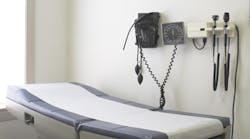Could the primary-care physician’s office be the next nontraditional practice setting for dental hygienists?
The key to getting oral health care to underserved populations may not be the dental practice—it could be the primary-care physician's office, offering dental hygienist a new nontraditional practice setting in which to expand their careers. We all know that oral health is an integral component in overall health. There have been numerous articles and courses on the link between oral disease and systemic disease. The US Department of Health and Human Services (HRSA) created a program entitled “The Integration of Oral Health and Primary Care Practice Initiative.” This initiative’s goal is to improve access to early detection and preventive interventions by expanding the oral-health clinical competency of primary-care clinicians, leading to improved oral health. (1)
The executive summary of the above report discusses the lack of access to oral health care by vulnerable populations, including children. While acute care is sometimes available, ongoing care is often lacking or nonexistent. The 2011 Institute of Medicine (IOM) reports, “Advancing Oral Health in America” and “Improving Access for Oral Health for the Vulnerable and Underserved,” recommended that the HRSA address the need for improved access to oral health care through the development of core competencies for health-care professionals. (2, 3) Below is an excerpt from Advancing Oral Health in America:
Oral health care is often excluded from our thinking about health. Taken together with vision care and mental health care, it seems that problems above the neck are commonly regarded as peripheral to health care and health care policy. This division is reinforced by the fact that dentists, dental hygienists, and dental assistants are separated from other health care professionals in virtually every way: where they are educated and trained, how their services are reimbursed, and where they provide oral health care. This separation is at odds with the fact that good oral health has been shown to directly affect a person’s overall health. (2)
Disparities exist, not only in access to the latest in life-saving technology but also in access to the most basic of routine health care. More than half of the population does not visit a dentist each year. (3) Those that are poor and/or living in rural areas suffer the most. Older adults and the disabled are also more at risk for more disease and lack of care.
As mentioned, oral health is essential for healthy development and healthy aging, yet across the United States there is an excessively high incidence of oral disease. A new white paper proposes integrating preventive oral health care as a component of routine medical care and arranging referrals to an oral healthcare provider. The “Oral Health Delivery Framework” provides a practical method for primary-care teams of all types to engage patients and families in the prevention and early detection of oral disease. (4) “Oral Health: An Essential Component of Primary Care” includes an executive summary, a white paper, an introductory video, and case examples from early leaders. The report’s suggestions are being field tested by over 12 private practices and community health centers in five states.
READ MORE | 5 tips for creating a dental hygiene cover letter that gets you noticed
Call to action
We know that a person’s oral health impacts their life and health on many levels, and most importantly, that most oral disease is preventable. Those with the most need receive the least care. In order to rectify this situation, we all need to engage patients and families, and make oral health care more accessible. The “Oral Health Delivery Framework” is a conceptual framework for how to address oral health in the primary care setting.
Upon reading the “Role of Dental Professionals: Implementation of the Oral Health Delivery Framework,” I had a vision of a nontraditional practice setting. This is not new, but few dental hygienists take the opportunity to expand their practice horizons. While the framework does not require on-site oral health-care professionals in order to be implemented, dental hygienists or dental assistants can work in a primary-care medical practice and provide additional services to the patient. To ensure integration, it is important for oral health-care professionals to function as full members of the primary-care team.
According to the report, while oral health-care professionals can offer an important opportunity to expand the reach of the practice to address patients’ oral health needs, their presence on the care team should not preclude primary-care providers or other medical support staff from fully engaging in preventive oral health care. State dental practice acts and other rules and regulations may require non-dentist dental professionals to work under the supervision of a dentist in some states; primary care practices can explore options available to them in their state.
Another idea for a new practice setting!
References
1. Integration of Oral Health and Primary Care Practice. US Department of Health and Human Services Health Resources and Services Administration website. http://www.hrsa.gov/publichealth/clinical/oralhealth/primarycare/integrationoforalhealth.pdf. Published February 2014. Accessed January 13, 2016.
2. IOM (Institute of Medicine). Advancing Oral Health in America. Washington, DC: The National Academies Press. http://iom.nationalacademies.org/reports/2011/advancing-oral-health-in-america.aspx.
3. IOM (Institute of Medicine) and NRC (National Research Council). 2011. Improving access to oral health care for vulnerable and underserved populations. Washington, DC: The National Academies Press. http://iom.nationalacademies.org/Reports/2011/Improving-Access-to-Oral-Health-Care-for-Vulnerable-and-Underserved-Populations.aspx.
4. Oral Health: An Essential Component of Primary Care. Safety Net Medical Home Initiative website. http://www.safetynetmedicalhome.org/sites/default/files/White-Paper-Oral-Health-Primary-Care.pdf. Published June 2014. Accessed January 13, 2016.







